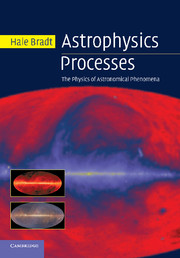Book contents
- Frontmatter
- Contents
- List of figures
- List of tables
- Preface
- Acknowledgments
- Also by the author
- 1 Kepler, Newton, and the mass function
- 2 Equilibrium in stars
- 3 Equations of state
- 4 Stellar structure and evolution
- 5 Thermal bremsstrahlung radiation
- 6 Blackbody radiation
- 7 Special theory of relativity in astronomy
- 8 Synchrotron radiation
- 9 Compton scattering
- 10 Hydrogen spin-flip radiation
- 11 Dispersion and Faraday rotation
- 12 Gravitational lensing
- Credits, further reading, and references
- Glossary
- Appendix: Units, symbols, and values
- Index
12 - Gravitational lensing
Published online by Cambridge University Press: 05 June 2012
- Frontmatter
- Contents
- List of figures
- List of tables
- Preface
- Acknowledgments
- Also by the author
- 1 Kepler, Newton, and the mass function
- 2 Equilibrium in stars
- 3 Equations of state
- 4 Stellar structure and evolution
- 5 Thermal bremsstrahlung radiation
- 6 Blackbody radiation
- 7 Special theory of relativity in astronomy
- 8 Synchrotron radiation
- 9 Compton scattering
- 10 Hydrogen spin-flip radiation
- 11 Dispersion and Faraday rotation
- 12 Gravitational lensing
- Credits, further reading, and references
- Glossary
- Appendix: Units, symbols, and values
- Index
Summary
What we learn in this chapter
Gravitational fields distort space, and light beams follow null geodesics, the “straight lines” of curved space. To a human observer, it appears that gravitational fields bend the paths of the rays. The bending angle of a light ray passing near a point-mass gravitational “lens” is deduced from Newtonian arguments, except that the proper result from general relativity (GR) is twice that so obtained, as was famously confirmed during the solar eclipse of 1919. Gravitational lensing phenomena now allow astronomers to detect otherwise invisible gravitational matter known as dark matter.
A quasar is a distant, luminous, and often variable active galactic nucleus (AGN). Electromagnetic rays from a quasar that pass through the gravitational field of an intervening galaxy can appear to an observer as multiple images of the quasar. The twin quasar Q 0957+561 was the first discovered example in 1979. The image positions for point-mass lensing can be deduced from the physical bending angle expression along with the geometric ray tracing equation, which together yield a lens equation. The images may be either magnified or demagnified. Because the surface brightness of any image equals that of the source, an unresolved magnified (or demagnified) image will appear as a point source with increased (or decreased) flux density. The magnification factor of all images of a point source, taken together, is always greater than unity. […]
- Type
- Chapter
- Information
- Astrophysics ProcessesThe Physics of Astronomical Phenomena, pp. 437 - 482Publisher: Cambridge University PressPrint publication year: 2008



